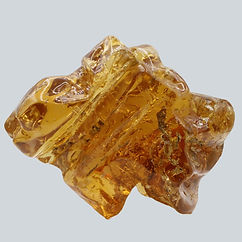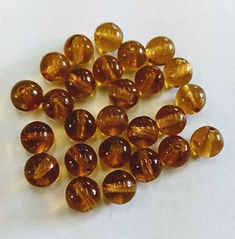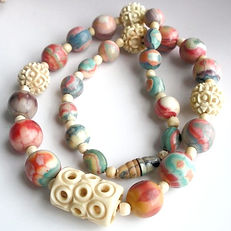Currently Empty: $0.00

We explore the various fake Baltic Amber and how you can tell the difference.
Throughout history, humans have always tried to copy nature in some way. A group of scientists synthesized amber during the early 18th century. Natural materials were copied and slowly introduced to the market as less valuable copies. Due to their use as jewellery, these pieces were expensive.
Many people don’t even realise that fake Baltic amber is flooding the market nowadays. Because they cannot tell the difference, people purchase these amber pieces and consider them to be genuine. As a result, many of these people are exploited since fake amber is usually sold for a high price.
Anyone can be deceived and may not be able to tell the difference. An individual with a good understanding of the healing powers, texture, and quality of amber can differentiate fake amber from real amber.
A trustworthy source, like Baltic Amber Masters, is the best place to purchase a genuine Baltic amber piece. If you are looking for authentic amber, this will greatly reduce the chance of purchasing fake amber.
Is there anything else that looks like Amber?
There are many Fake Baltic Amber lookalikes. In order to tell the difference, it is essential to know their existence. It should be easy if you have purchased a genuine amber piece as recommended above. The following stones resemble amber:

Copal:
A younger form of tree resin, Copal is sometimes sold as amber because it looks similar to it, but it is fact a lot younger form of tree resin. Copal will melt at a much lower temperature than Amber and emits a sweet smell. Amber will melt around 250-350 degrees Celsius, while Coal will melt at around the 150 degrees Celsius mark.

Glass:
This is probably the easiest Amber substitute to distinguish, as it weighs a lot more than amber, is not able to be easily scratched, will reflect light and will shatter if dropped. Also, as it is machine made, it will appear to be too “perfect” in shape and colour. Real amber will have slight imperfections and colour variations.

Phenolic Resin:
Most of the time, they are used in the manufacture of beaded jewellery. Their shape and colour are identical to those of amber. Jewellery made of phenolic resin is difficult to distinguish from real amber. You can tell if phenolic resin is fake if you burn it and it doesn’t give off the same pine-tree scent that authentic amber does.

Celluloid:
It is impossible to tell the difference between celluloid and amber at first glance. Burning celluloid, however, would give off a smell of burnt plastic, indicating that the object is an imitation of amber. Amber is also more flammable than celluloid.

Casein:
Casein is a milk protein that looks similar to amber. It is much heavier, plastic-like material that can be differentiated by burning it, as it also emits the odour of burnt plastic when burned.
Tests to identify fake Baltic Amber
You can perform different tests to determine whether the amber you are purchasing or already own is genuine. The most effective way to differentiate the two is by smell, as Amber burns with a pine-tree aroma. You can, however, perform some tests to determine whether your amber piece is real or a convincing fake if you want to avoid burning your jewellery:
- Salt Water Test (Easiest & Most Effective):The test is extremely simple and effective. Mix two cups of warm water with a quarter cup of salt in a bowl, then stir the mixture until the salt dissolves completely. Then, place the piece of amber in the solution. It is authentic amber if it floats to the top.
- Rubbing Test (Simple & No Mess): When you rub real amber on your palm, it is said to give off its iconic pine-tree scent smell. It is caused by friction between your hand and the amber piece which produces a heating effect. If you use this method and your amber piece does not smell like pine trees, it is probably not authentic.
- Feel Test (Straightforward & Super Easy):Amber is lightweight and slightly warm to the touch. As a result of being underground for millions of years and its chemical composition, it has this characteristic. Because glass is harder, cooler, and heavier than authentic amber, you can distinguish fake amber from the real thing.
- Hardness Test (Quick & Uncomplicated):You can also check your amber piece’s hardness easily. You can immediately determine whether an amber piece is real or not by conducting this test. Amber is a relatively soft material. Fakes tend to be hard solids or feel plastic.
- UV Test (No Experience Needed): For those who have spent a lot of money on amber, this is the best test. UV lamps are needed for this. The colour of amber changes to blue or green when exposed to UV light. If your amber piece appears another colour under the light, it isn’t true amber.
- Hot Needle Test (Best Done by Amber Experts): It is mainly used to detect fake plastic. When you insert a hot needle into a plastic object, it melts, but if it is made of real amber, it will crack. The only way to tell if a piece is genuine amber is to smell it, and if it smells like pine-tree resin, it probably is. Note: Do not conduct this test on small amber beads, as they may be completely destroyed.
- Heating Test (Best Done by Amber Experts): The purpose of this test is to determine whether the amber piece contains any other materials. Natural ambers contain tiny bubbles in their microscopic structure. Amber becomes transparent when the bubbles inside it evaporate from heat. Amber becomes darker at higher temperatures
Note: Do not conduct this test on small amber beads, as they will melt completely.
Conclusion – How to tell if amber is real
As amber stone is a natural healing stone, by synthesizing and creating fakes of the original, we are only making it harder for those seeking assistance when using amber for spiritual healing. It is also something which we at Baltic Amber Masters do not support. We appreciate the natural wonderful stone of amber, and people who are faking and misrepresenting amber with their knock off products are doing nobody any good other than themselves by profiteering.
You should be careful when choosing amber for yourself or someone else. You may not only be overcharged for a fake, but you may also be purchasing something that is not healing.
While the tests mentioned in this article are great for amber you’ve already purchased, you can also have pieces checked by a professional. You should only buy amber pieces from merchants who you can rely on, have a 100% guarantee and return policy if not satisfied.

